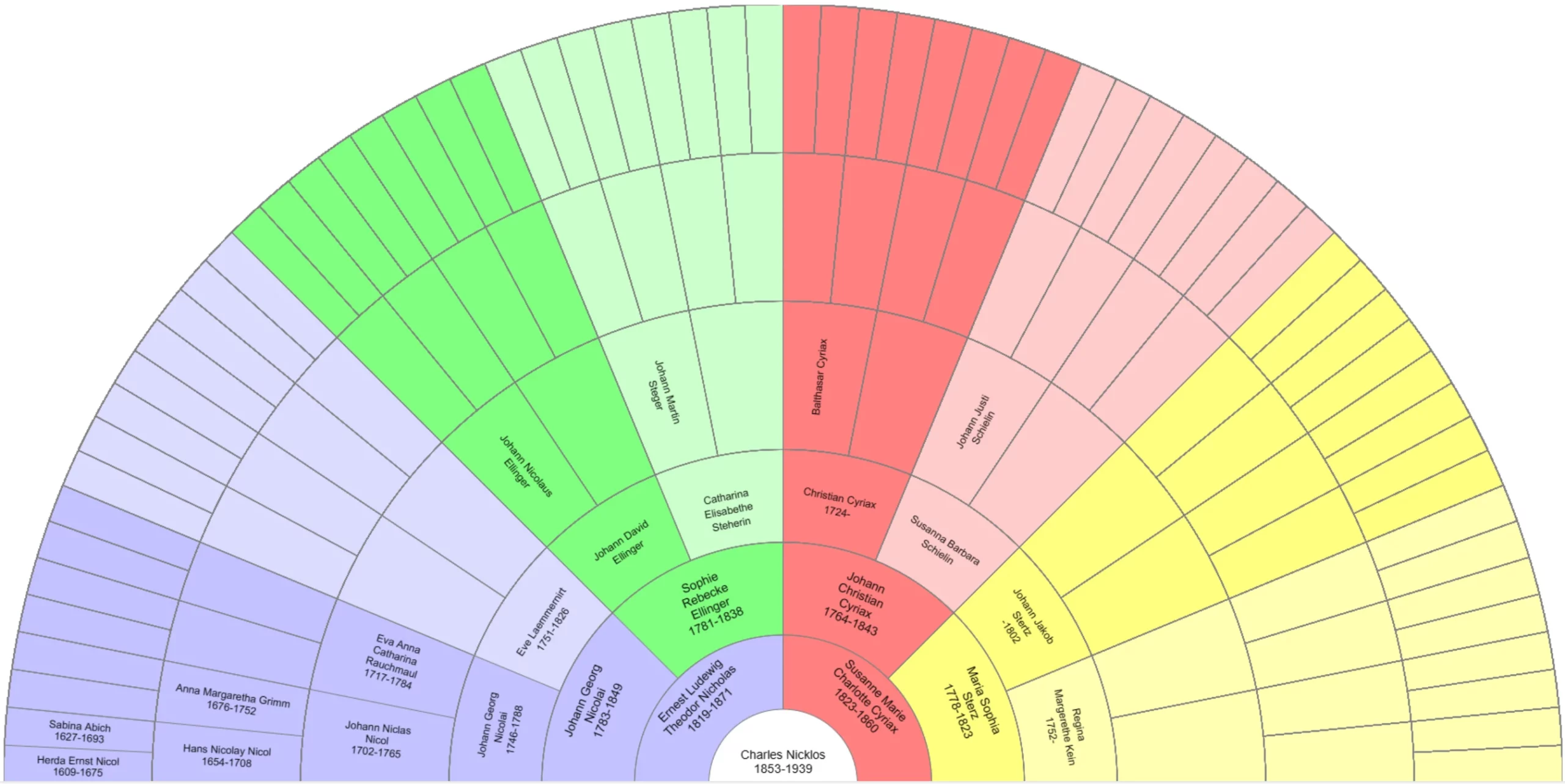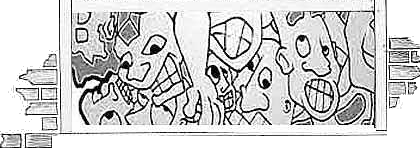When we last left the Nicolai family, we had learned that Johann Georg, born to Georg, had married Sophie Rebecca Ellinger in Elxleben, Thuringia in 1809. Yet, the documents had remained largely untranslated. Time to get serious with the Kurrentscript. Two tools provided initial help. First, Transkibus.com, an AI powered website portal, converts scanned Kurrentscript into German. Then comes a language translator, in this case Deepl.com, to convert the German to English. Most important is the patient assistance that fellow on-line German researchers have provided, specifically Petra D., Gudrun B., and Frank S. They understand the subtleties of German genealogy, geography and culture.
Family of Johann Georg and Sophia Rebecke (Ellinger) Nicolai
The deep dive into the various record books, available at the wonderful Archion.de website, uncovered quite of bit of additional information. In particular, the Warza church has a set of books called a Seelenregister (or Soul Register). Apparently, the local priest would produce a census for each church member in the form of a family tree. Three different books survive from the 19th century, each with an extraordinary amount of detail. The comments and tree below reflect this increased understanding of the Nicolai family.
- Johann Georg had a short-lived marriage in 1808 to Susanna Maria Kolbe. Not sure what happened since no mention gets made of her again.
- Johann Georg was born on 3 Jul 1783 in Lauterbach near Gotha. Turns out Germany has multiple towns of the same name. Our Lauterbach is a small rural village in the county of Wartburgkreis and in the state of Thuringia.
- Johann Georg worked as a Hufschmied which translates to farrier or horse shoer and a Waffenschmied – a weapons maker. His father, Georg, worked also as a farrier and served as a court clerk.
- Johann Georg had a brother, Johann Freidrich, who was present at the baptism of his first child.
- The family may not have lived initially in Elxleben (north of Erfust) as previously assumed. The Seelenregister repeatedly spells the town as “Aelkschleben”, which may simply be an alternative spelling. Yet we also cannot rule out another Elxleben, south of Erfurt with a nearby Alkersleben. Most likely, however, is the town of Andeleben, a mere 5 miles from Elxleben. The godmother for Johanne Catharine Louise came from this town in 1817 for the baptism.
- Sophie Rebecke had a child, Anna Catharina, from a previous marriage in 1804 to Johann Martin Burkhardt. He died in 1807. Anna Catharina never married, but had three children, two of whom married in Warza. Any of their descendants would be half cousins.
- Notice that two individuals had children to unnamed fathers. Out-of-wedlock babies were accepted within the community with estimates approaching 10% of births. The church felt strongly that all individuals should be baptized to save their souls. In addition, a segment of the population could not cover the necessary expenses for a wedding. Therefore, the children would take the mother’s last name.
- Martha (Wiegand) Nicolai lost her first two children when she was pregnant with her third in 1845. She then became widowed in 1849. Her stepson, Ernst Nicholas, would leave the following year in 1850 for Rochester. Not sure what happened to her or her daughter (more possible half cousins) as they apparently moved to the big city of Gotha.
Click here to see Records for Family of Johann Georg Nicolai and Sophie Rebecke Ellinger
1808 Nicolai -Kolbe Marriage (source: familysearch)

German:
English Translations:
1811 Johann Gottfried Ephrajim Nicolai Baptism (source: familysearch)

German:
English Translations:
Soul Register for Nicolai in Warza Book 2 (Warza Seelenregister 18./19. #2, Pg 46)
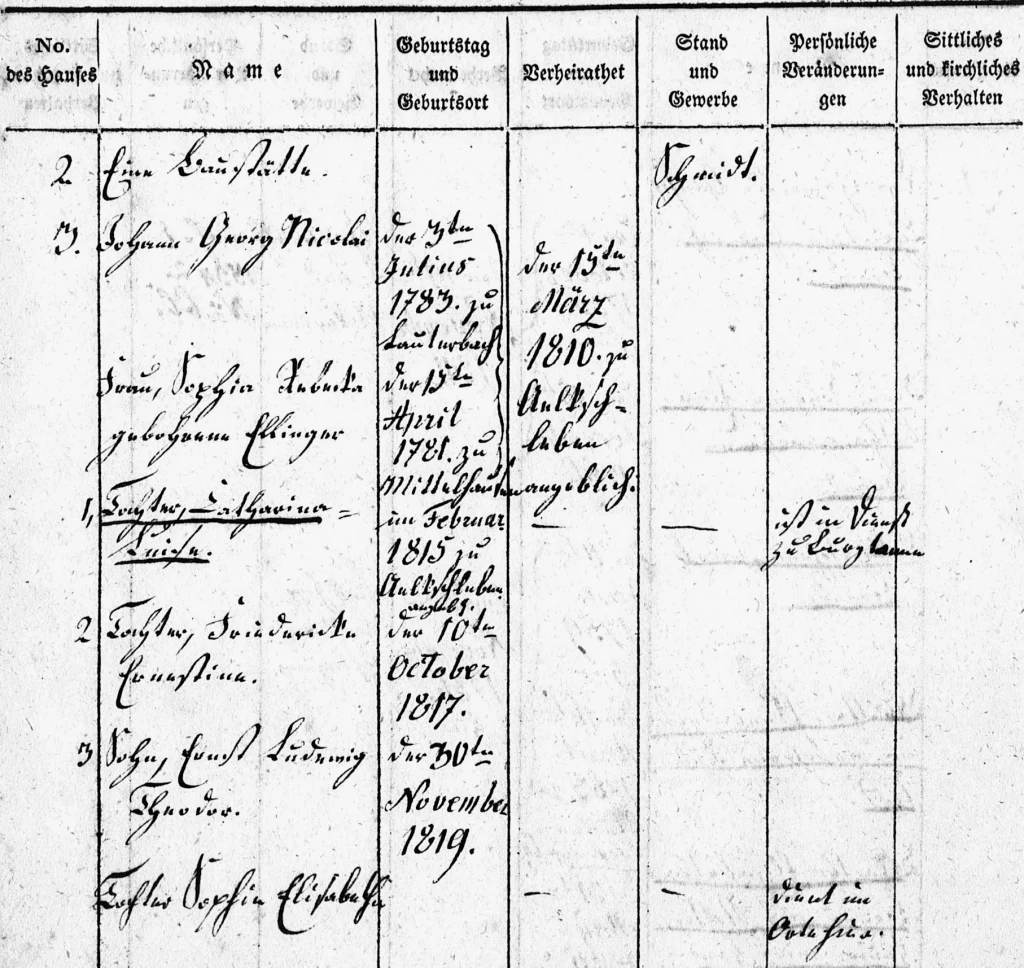
English Translations:
Johann Georg Nicolai born 3 Jul 1783 in Lauterbach
Frau Sophia Rebecke nee Ellinger born 15 Apr 1781 in Millelhausen
married 15 Mar 1810 Aulkschleben
Soul Register for Nicolai in Warza Book 3 (Warza Seelenregister 18./19. Bk #3, Pg 84)
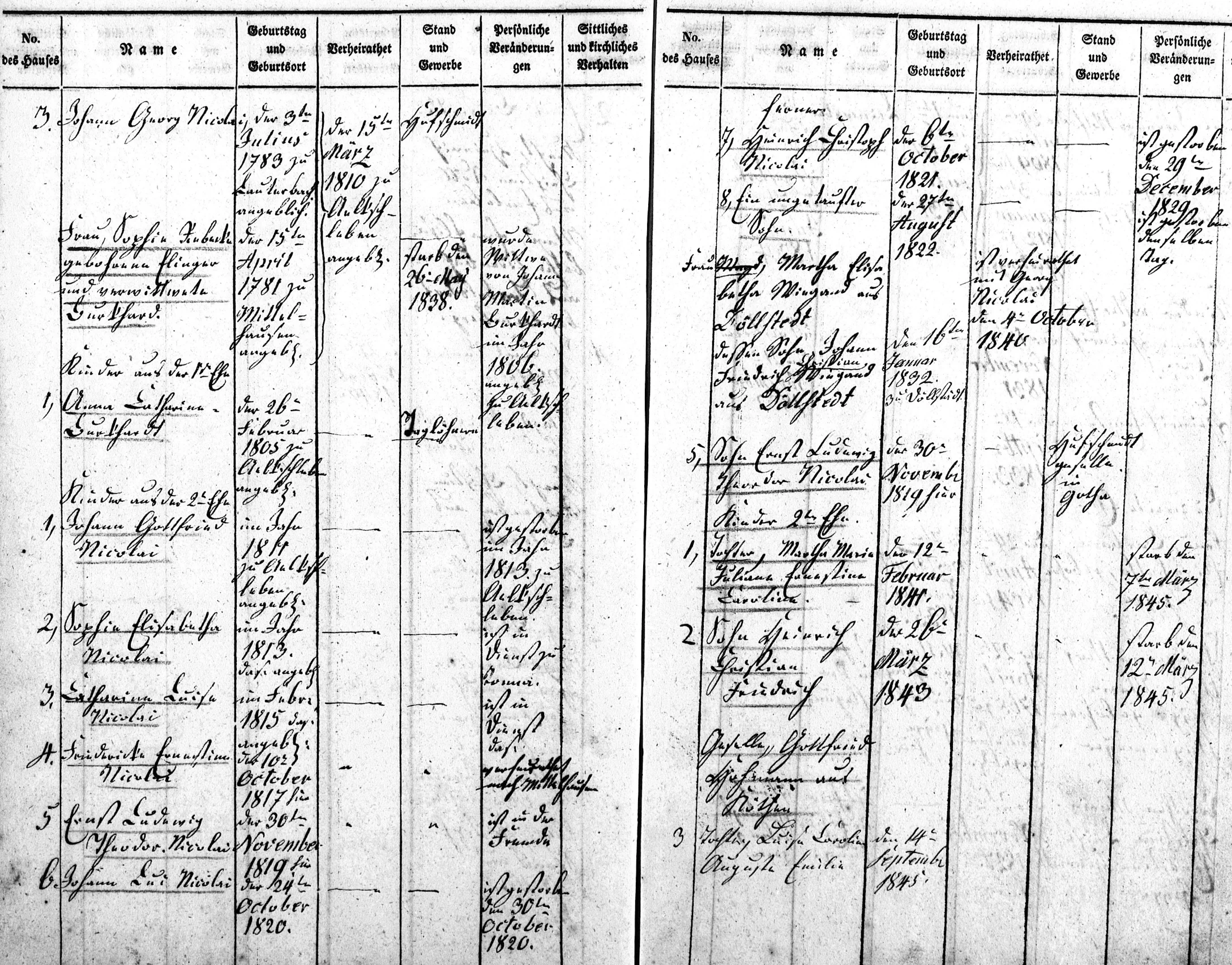
German:
Johanna Sophia, Mstr. Georg Nickols und
Schmidt
English Translations:
Soul Register for Nicolai in Warza Book 4 (Warza Seelenregister 18./19. Bk #4, Pg 8)
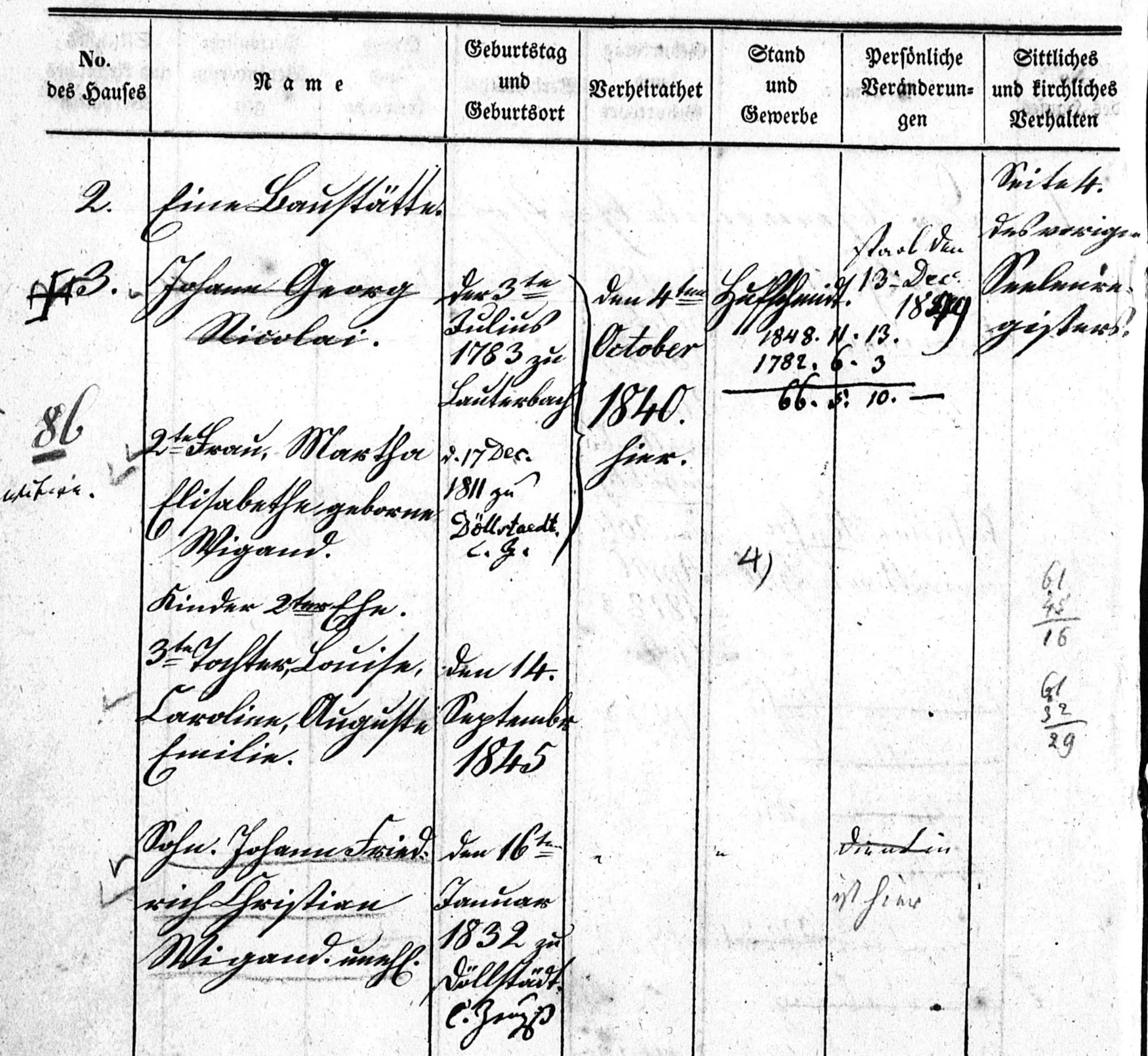
German:
English Translations:
Nicolai and Napoleon
The Napoleonic war can help explain how Johann Georg Nicolai moved from Lauterbach to Elxleben, then to Warza. In July 1806, Napoleon had organized a group of defeated German states into the Confederation of the Rhine. He was still at war with other German states including Prussia which controlled Elxleben/Erfurt. The Duchies of Thuringia sat in the middle. Warza and Lauterbach were part of the Saxe-Gotha-Altenburg Duchy under Duke Augustus. He enthusiastically embraced Napoleon. However, Lauterbach sits oddly on a peninsula completely surrounded by the Saxe-Weimar-Eisenach Duchy. Its ruler, Duke Karl August, a longtime Prussian ally, personally led his troops near Erfurt to provide support. He bet on the wrong horse. Napoleon crushed Prussia at Jena and Auerstedt in October 1806. A huge number of 12,000 defeated soldiers swarmed Erfurt after their defeat refusing to return to their commanding officers which included Karl August. Within a few days, the “Capitulation of Erfurt” occurred with a city filled with demoralized soldiers.
The Thuringan Duchies then joined the Confederation of the Rhine. Not only did Duke Karl August pay a hefty fine, but he and his troops now fought for France. The expanded Confederation also included captured Prussian land where Napoleon created a special state called “the Principality of Erfurt”. It reported to France, not to the Confederation. So when Johann Georg married Susanna Maria Kolbe in 1808, Elxleben/Erfurt was under direct French control. Napoleon used the city that same year to host an elaborate meeting, named the “Congress of Erfurt”, to strengthen his alliance with Alexander I, the Emperor of Russia.
Johann Georg’s role in the war remains unclear. He lists his occupation as “Hufschmidt”. Given the large size of the cavalries at the time, he would have had plenty of work to keep him busy. Since he lived in the Principality of Erfurt, I would assume that he supported Napoleon.
The Principality of Erfurt fell in January 1814, and officially reverted back to Prussia in 1815. Notice that Johann Georg moved to Warza, located in Saxe-Gotha-Altenburg, sometime after the birth of his daughter in 1815. Warza would offer a welcoming environment for the former Lauterbach resident. Here, the Francophile Duke Augustus held his seat despite widespread unpopularity following Napoleon’s defeat. After the Duke’s death in 1822, his brother, Duke Frederick IV, succeeded until his death in 1825. Neither Duke left male heirs, resulting in the reshuffling of the territories with the formation of Saxe-Gotha and Coburg in 1826. Ernst Nicolai would leave this duchy in 1850.
Welcome to Lauterbach
Armed with the information above, off we go to the Lauterbach church record books, which Archion had fortunately scanned. Indexed records start after 1808. A quick look there reveals no Nicolai, but some intriguing listings for Nickol. Prior to 1808, births, marriages and deaths are listed chronologically in two church books (1737-1808 and 1620-1737) with no index. Last names tend to get underlined in these early church ledgers, a deceptively effective practice that eases the pain of searching.
As we will see, Lauterbach represents the family homeland with Nicklos ancestors documented there to 1650. A small rural village that lies at the foothills of Hainich National Park, Lauterbach gets its name came from the loud stream that runs through it. According to its early history, the population has remained small with the Seelenregisters (sadly, not among the surviving books) recording populations of 250-400 during the 1800’s (650 souls live there now). The land had a nice reputation for good timber, clean water and a quality hops.
Spelling of the family name varies significantly. You will see Nicol, Nikol, Nickel, Nickol, Nicolai. In addition, a trailing “s” would sometimes get added or an “in” could be used to feminize the last names of the women. Everyone in Lauterbach with a variation on this name came from this family. In general, it looks like people used Nicol in the beginning. Somewhere before 1800, they settled on Nickol. When Johann Georg moved away, he adopted Nicolai.
Family of Johann Georg and Eva Catharina (Lämmerhirt ) Nickol
The second Church record book contains the baptism records for Johann George Nickel in 1783, and for his brother, Georg Friedrich, in 1785. His father’s name was Johann Georg Nickol who was a blacksmith. In his marriage record, Georg Freiedrich describes himself as the 4th son. Also found was a daughter born in 1780.
Johann George Nickol married Eva Catharina Lämmerhirt. Her last name shows up frequently, so I would anticipate her ancestors can be traced back several generations in this village.
If you look at the dates, you will see that the father, Johann Georg, died as young man in 1788 leaving Eva Catharine with 5 small children ranging in age 3 to 13 years old.
As mentioned, the index in records after 1808 shows several Nickols. Some descended from Johann Heinrich who remained in the village. Georg Friedrich, an organist, married in Lauterbach, then moved to Körner. His trail ends in 1820 with one surviving daughter in tow. Johann Conrad and Johanna Sophia may also have moved away since the church books do not record their deaths.
Click here to see Records for Family of Johann Georg Nicols and Eva Catharina Laemmernirt
1774 Nicol-Laemmernirt Marriage (Lauterbach Kirchenbuch 1737-1808, Pg 45)
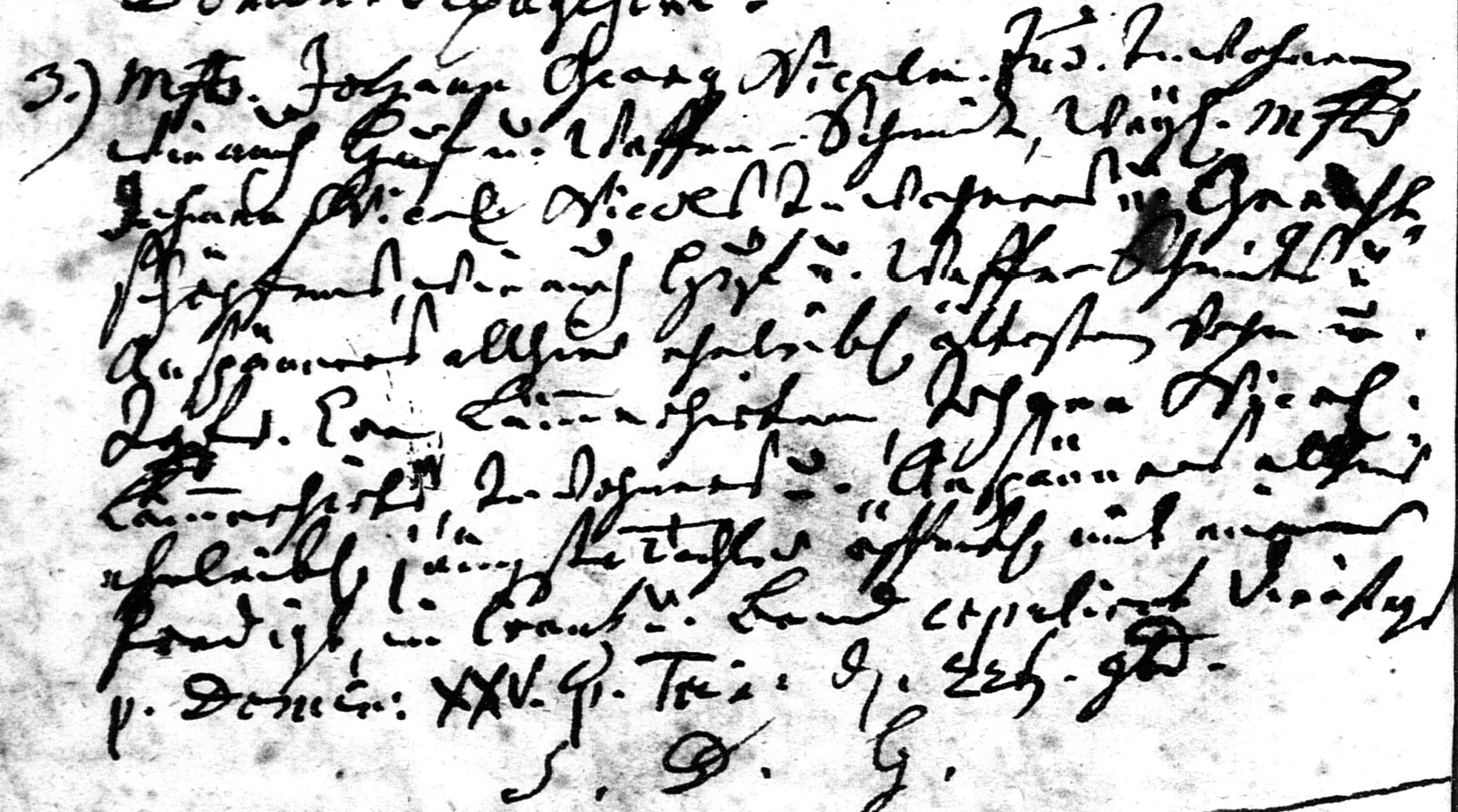
German:
Dom: XVII. p. Trin: A. mahl ausgeboren Johann Nicol Nikols
Jung gevollen u. hus alhier,___Johann Nicol Nickols
Auszamers alhier _ . Sohn,
und J. Eva Catharina Rauchmaulin, Hanss Henrich
Rauchmauls, Burgors zu u. Jungo hofs
Muhlberg ehelibe tochter
English Translations:
Cathedral: XVII. p. Trin: offered for the A. meal Johann Nicol Nikols, bachelor and Hufschmidt alhier, weyl: Johann Nicol Nickols, Anspänners alhere married. Son, and J. Eva Catharina Rauchmaulin, Hans Henrich Rauchmauls, citizens of Freutzb and resident of the Mühlberg farm, married. Daughter.
1775 Johann Heinrich Nicol Baptism (Lauterbach Kirchenbuch 1737-1808, Pg 35)
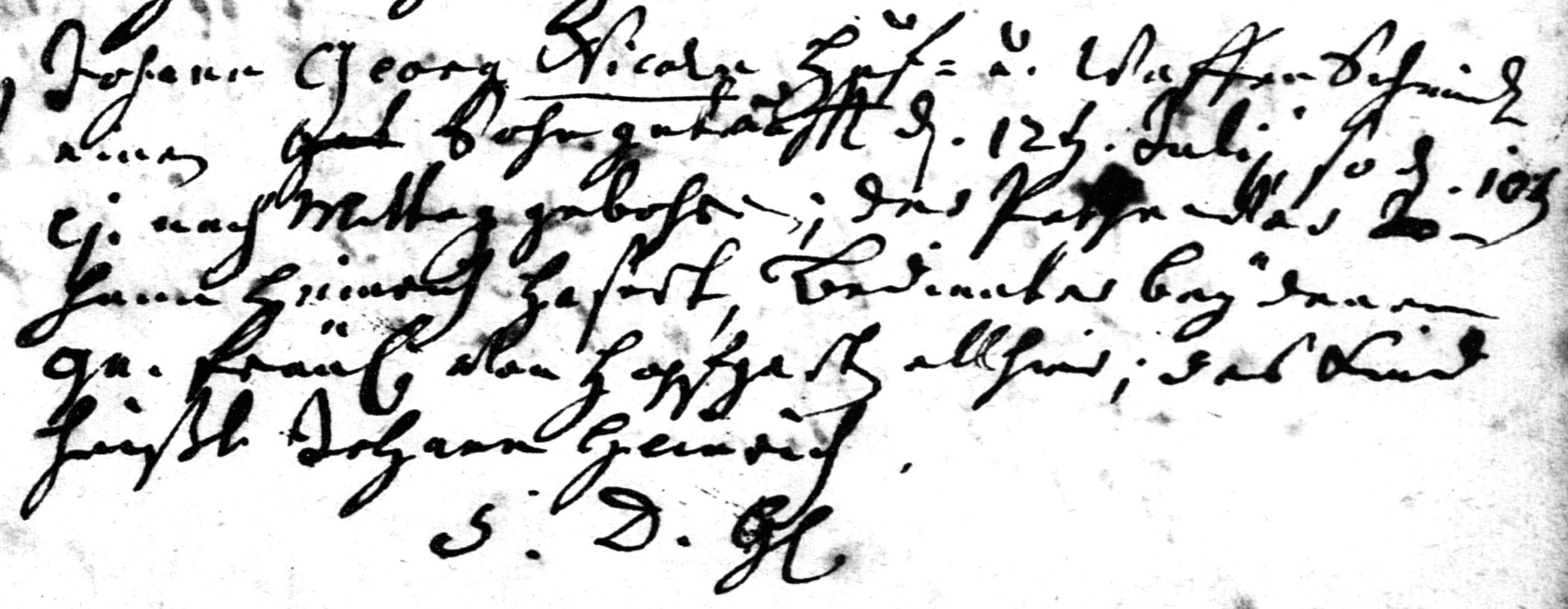
German:
Johann Georg Nicols Huf= u. Waffen Schmidt
getauft der 12te Juli
end nach Mittag geboren;
English Translations:
Johann Georg Nicols Blacksmith baptsm on the 12th July
1777 Johann Conrad Nicol Baptism (Lauterbach Kirchenbuch 1737-1808, Pg 38)
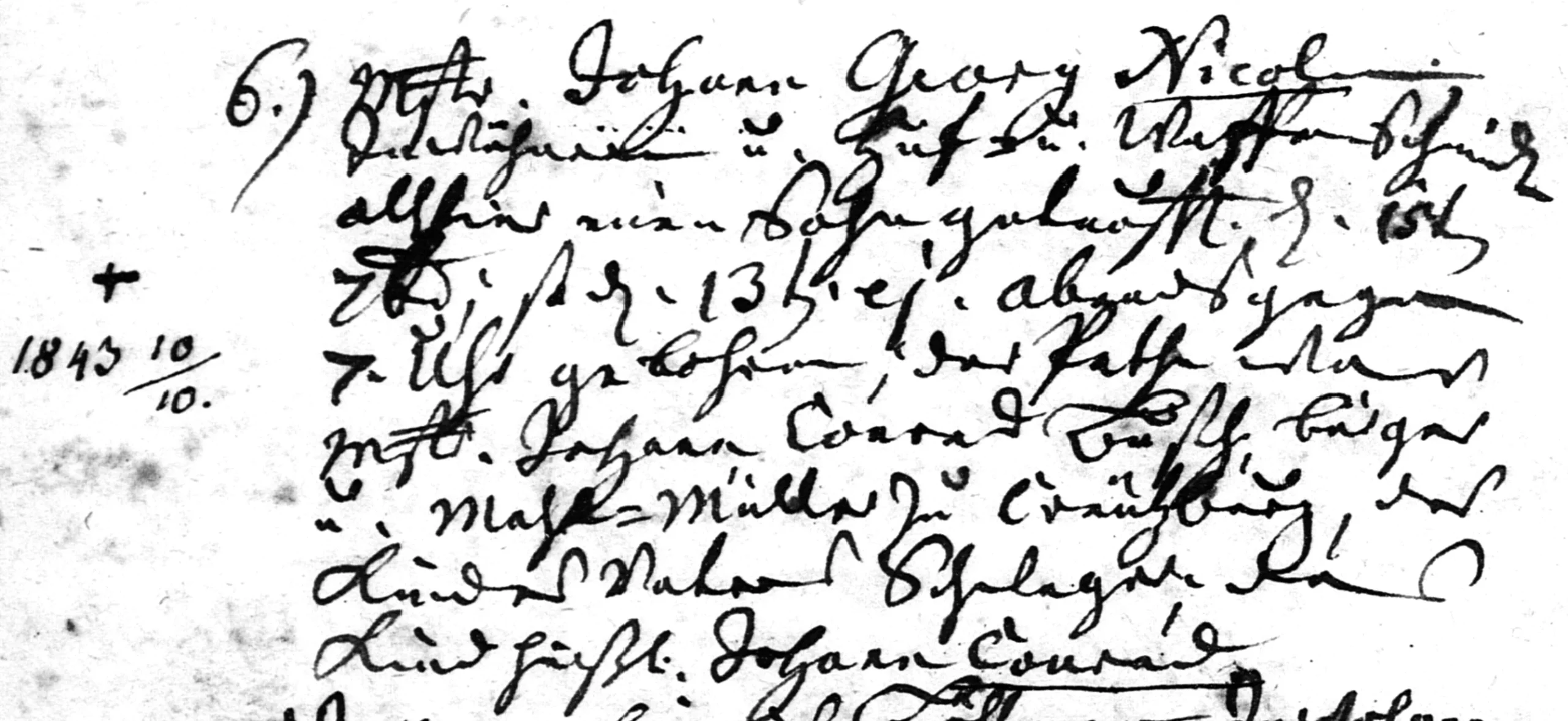
German:
Mstr. Johann Georg Nicol
Einwohner u. Huf- u. Wappen Schmidt
ahhier geboten.
Pater Mstr. Johann Conrad Luft
English Translations:
C
1780 Johanna Sophia Nickols Baptism (Lauterbach Kirchenbuch 1737-1808, Pg 41)
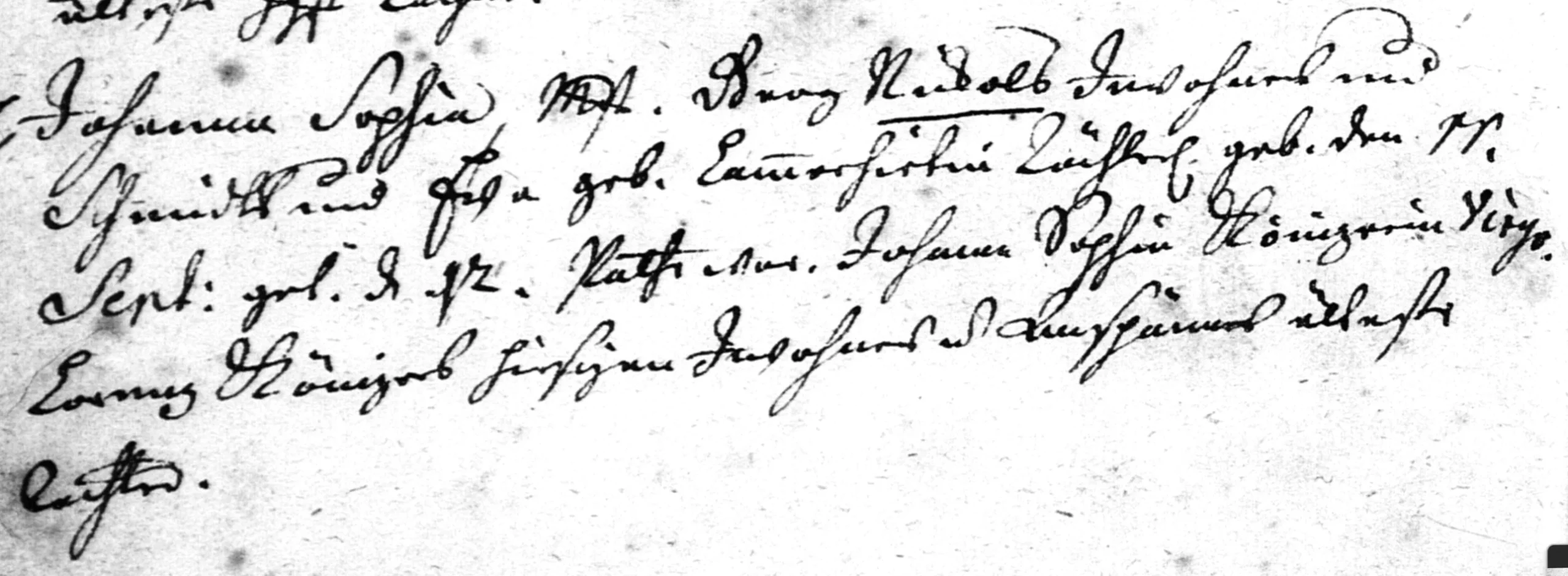
German:
Johanna Sophia, Mstr. Georg Nickols und
Schmidt
English Translations:
1783 Johann George Nicolai Baptism (Lauterbach Kirchenbuch 1737-1808, Pg 45)
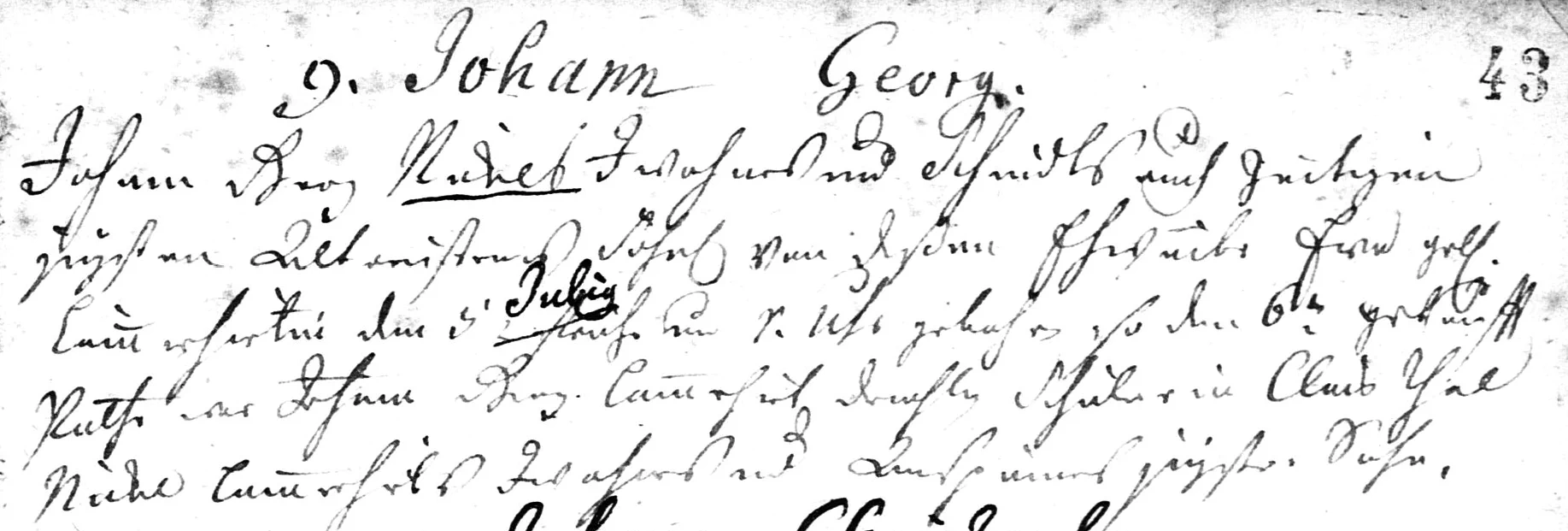
German:
Johanna Sophia, Mstr. Georg Nickols und
Schmidt
English Translations:
1785 George Friedrich Nickel Baptism (Lauterbach Kirchenbuch 1737-1808, Pg 48)
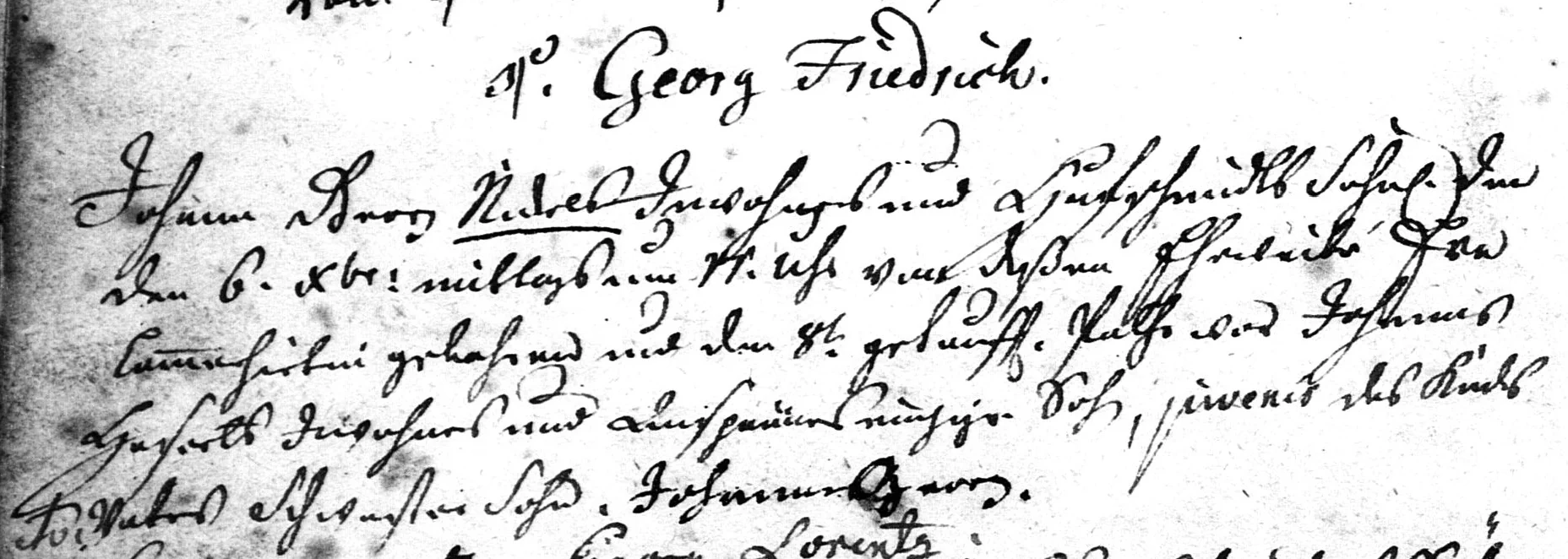
German:
Johanna Sophia, Mstr. Georg Nickols und
Schmidt
English Translations:
1788 Johann George Nickol Death Record (Lauterbach Kirchenbuch 1737-1808, Pg 137)

German:
Johanna Sophia, Mstr. Georg Nickols und
Schmidt
English Translations:
1826 Eve Nickol Death Record (Lauterbach Beerdigungen 1809-1875, Pg 45)

German:
Johanna Sophia, Mstr. Georg Nickols und
Schmidt
English Translations:
Family of Johann Nicol and Eva Anna Catharina (Rauchmaul) Nicol
From the records above, we learned Johann Georg Nicol was born in 1746 (from his death record) and that his father was Johann Nicol Nicol (from his marriage). Underlined names easily lead us to his baptism record and those of his siblings. Johann Nicol Nicol died in 1765, while his spouse Eva Anna Catharine died in 1784. The marriage was later found in the 1st Church Book.
Descendants of Johann Christoph remained in Lauterbach. Some would eventually settle in Ohio in 1860 where the Nickol surname survives.
Eva Anna Catharina Rauchmaul was born in nearby Mihlberg which had no church. Considered an estate farm, not a village, little trace remains now. It had the misfortune of lying at the border of East and West Germany. Per Wikipedia, in the early 1960’s the East German government, in Operation Cornflower, resettled the residents and demolished the buildings to create a buffer zone. My German contact, Gudrun B., gives a less edgy explanation. Apparently, the last remaining person, a little old lady, moved away.
The nearby Creuzburg church holds the baptism of Eva Anna Catharina, born to Johann Heinrich Rauchmaul and his second wife Anna Catharina Vehmel. Both of the Rauchmaul and Vehmel families came from the village of Großenlupnitz. Unfortunately, this parish has a gap in their records between 1614 to 1659 which will limit our ability to find additional ancestors.
Click here to see Records for Family of Johann Nicol Nicols and Eva Anna Catharina Rauchmaul
1734 Nicols-Rauchmaul Marriage (Lauterbach Kirchenbuch 1620-1737, Pg 73)

German:
Dom: XVII. p. Trin: A. mahl ausgeboren Johann Nicol Nikols
Jung gevollen u. hus alhier,___Johann Nicol Nickols
Auszamers alhier _ . Sohn,
und J. Eva Catharina Rauchmaulin, Hanss Henrich
Rauchmauls, Burgors zu u. Jungo hofs
Muhlberg ehelibe tochter
English Translations:
Cathedral: XVII. p. Trin: offered for the A. meal Johann Nicol Nikols, bachelor and Hufschmidt alhier, weyl: Johann Nicol Nickols, Anspänners alhere married. Son, and J. Eva Catharina Rauchmaulin, Hans Henrich Rauchmauls, citizens of Freutzb and resident of the Mühlberg farm, married. Daughter.
1737 Anna Catharina Nicols Baptism (Lauterbach Kirchenbuch 1737-1808, Pg 5)

German:
Johann Georg Nicols Huf= u. Waffen Schmidt
getauft der 12te Juli
end nach Mittag geboren;
English Translations:
Johann Georg Nicols Blacksmith baptsm on the 12th July
1740 Anna Barbara Nicols Baptism (Lauterbach Kirchenbuch 1737-1808, Pg 6)
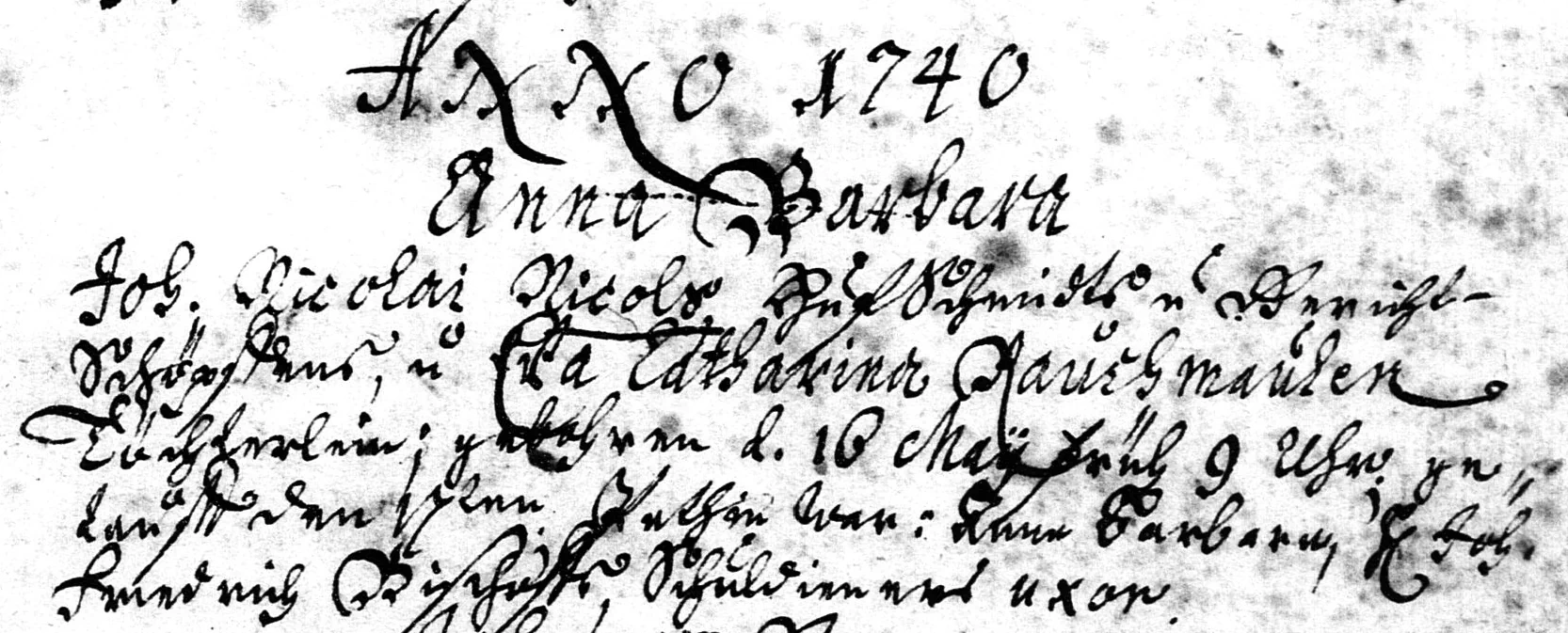
German:
English Translations:
1743 Anna Catharina Nicols Baptism (Lauterbach Kirchenbuch 1737-1808, Pg 8)

German:
Johanna Sophia, Mstr. Georg Nickols und
Schmidt
English Translations:
1746 Johann Georg Nicolai Baptism (Lauterbach Kirchenbuch 1737-1808, Pg 11)
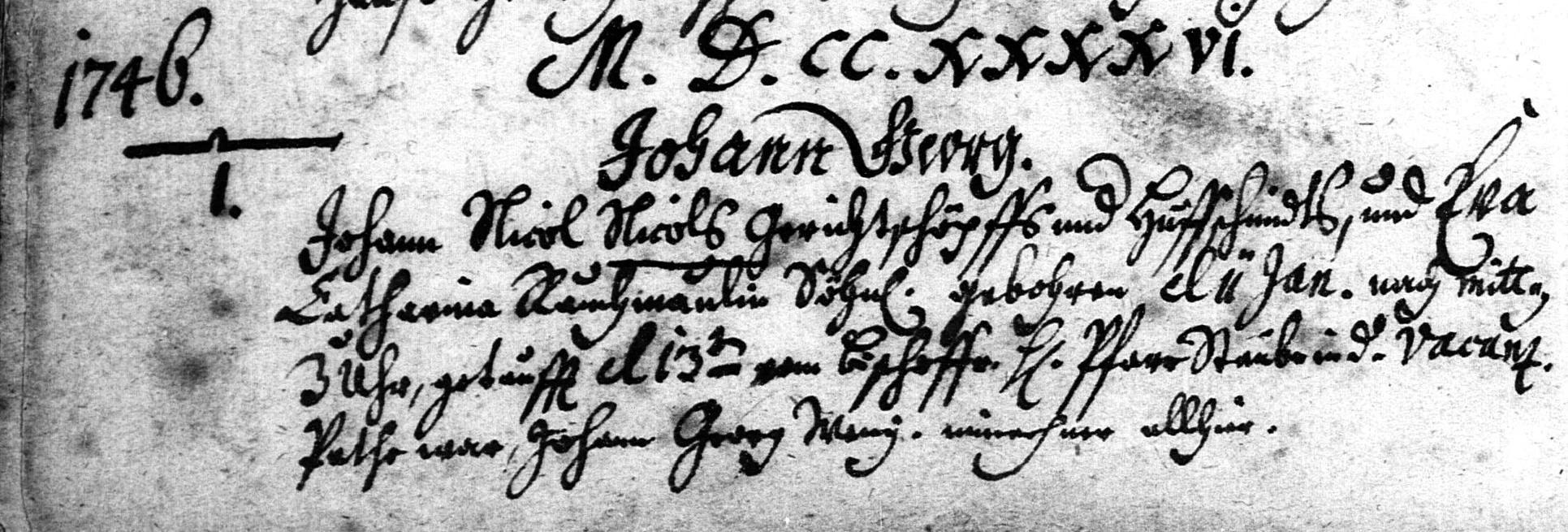
German:
Johanna Sophia, Mstr. Georg Nickols und
Schmidt
English Translations:
1748 Anna Maria Nicols Baptism (Lauterbach Kirchenbuch 1737-1808, Pg 15)

German:
Johanna Sophia, Mstr. Georg Nickols und
Schmidt
English Translations:
1751 Johann Christoph Nicols Baptism (Lauterbach Kirchenbuch 1737-1808, Pg 8)

German:
Johanna Sophia, Mstr. Georg Nickols und
Schmidt
English Translations:
1761 Nicols – Hasert Marriage (Lauterbach Kirchenbuch 1737-1808, Pg 88)
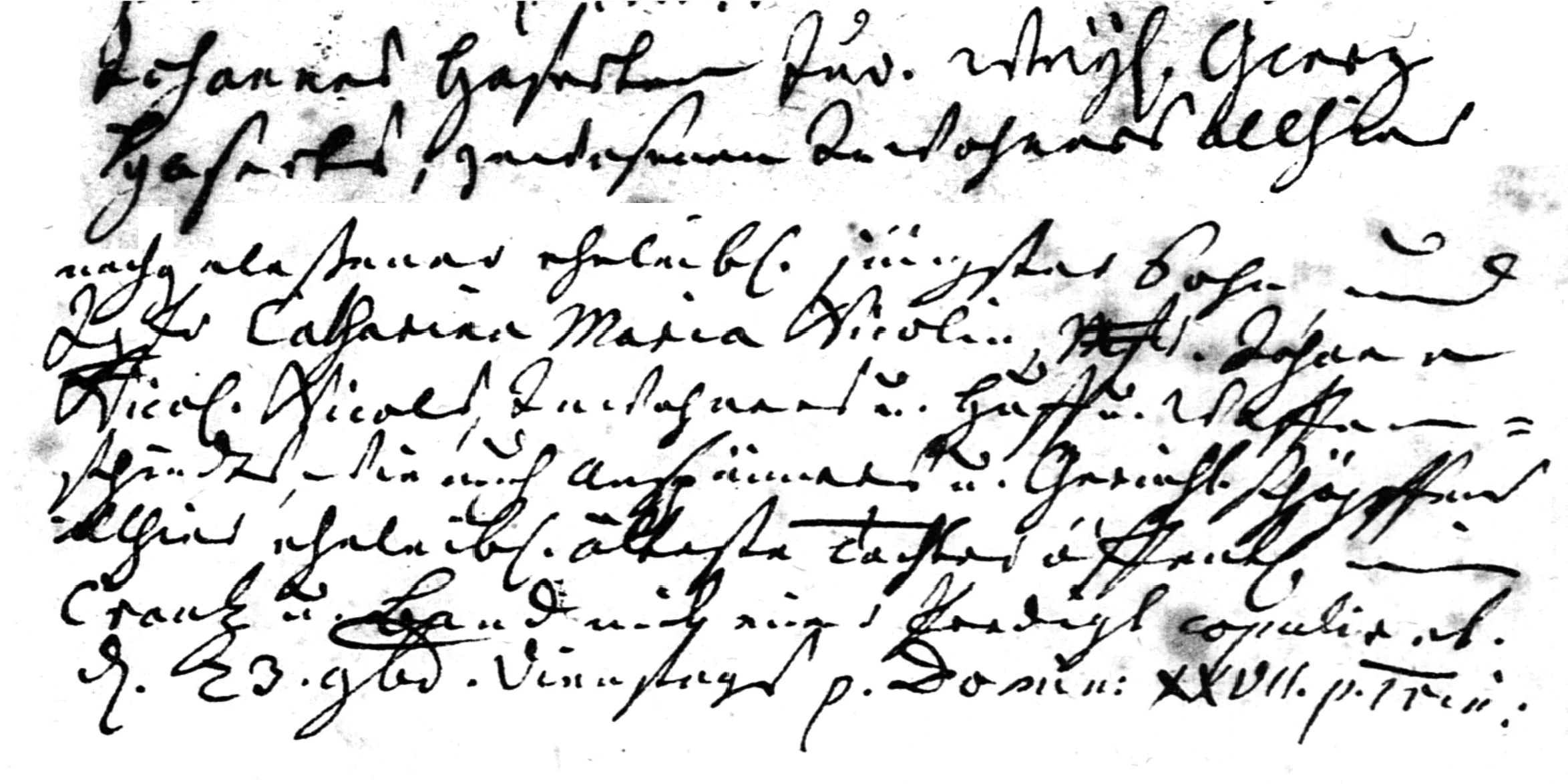
German:
English Translations:
1765 Johann Niclas Nicol Death (Lauterbach Kirchenbuch 1737-1808, Pg 121)
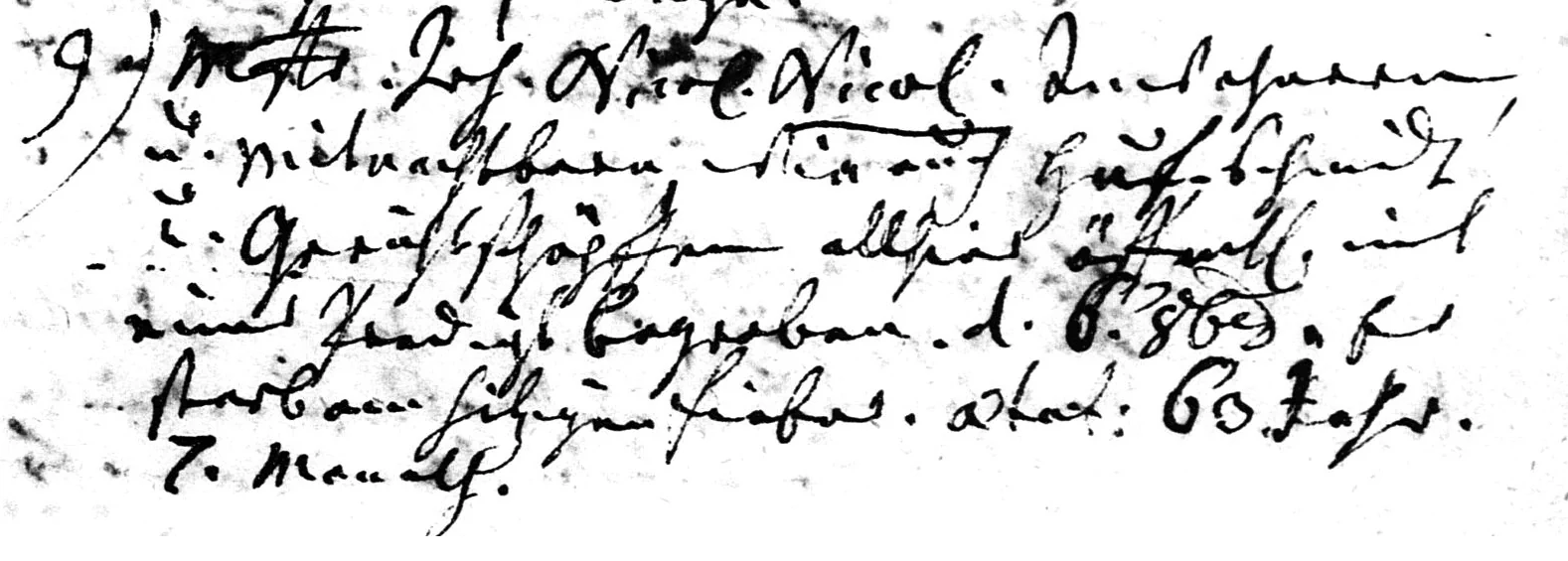
German:
Johanna Sophia, Mstr. Georg Nickols und
Schmidt
English Translations:
1761 Nicols – Schatzen Marriage (Lauterbach Kirchenbuch 1737-1808, Pg 91)
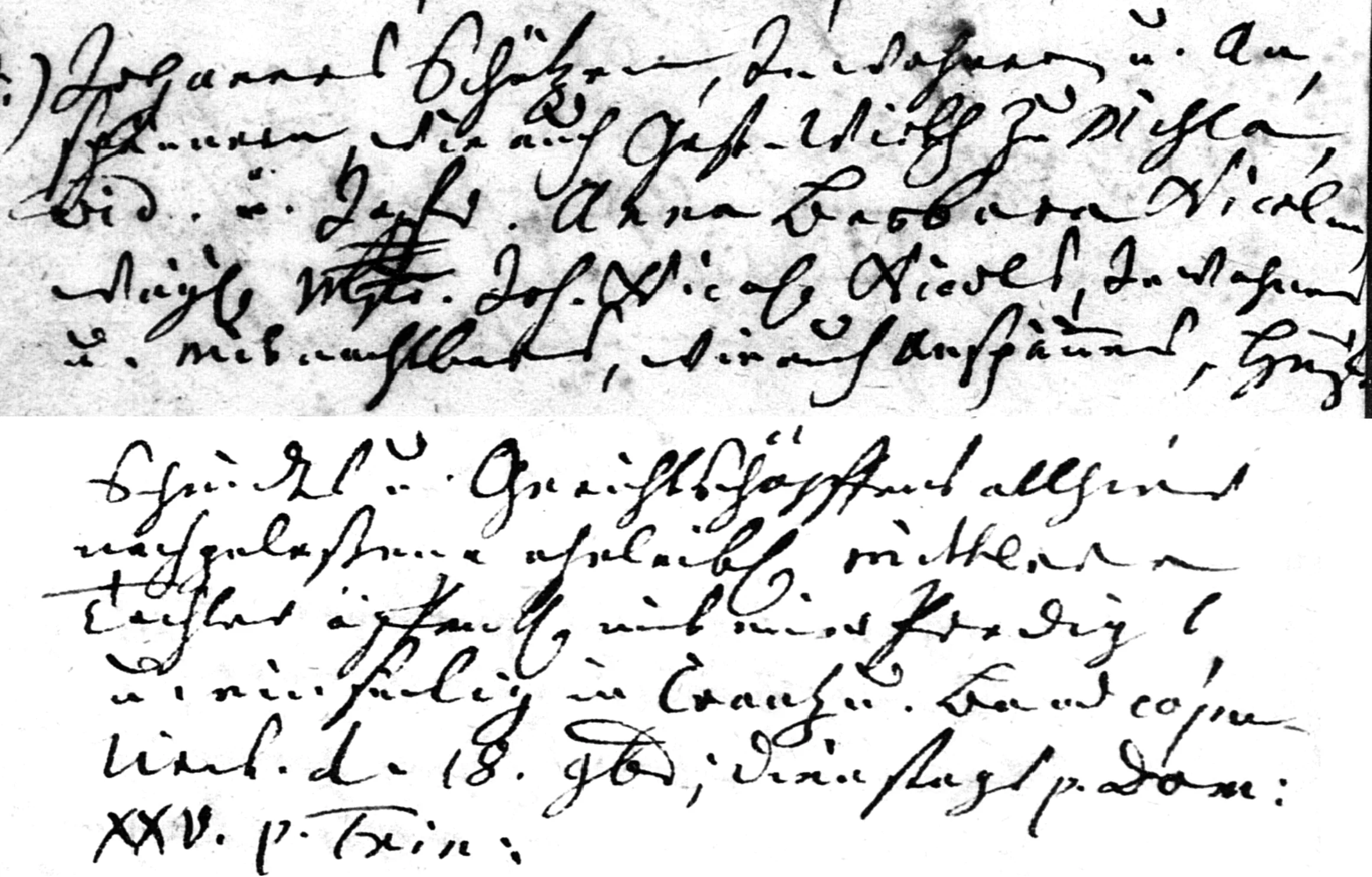
German:
English Translations:
1784 Eva Anna Catharina Nickolin Death (Lauterbach Kirchenbuch 1737-1808, Pg 135)
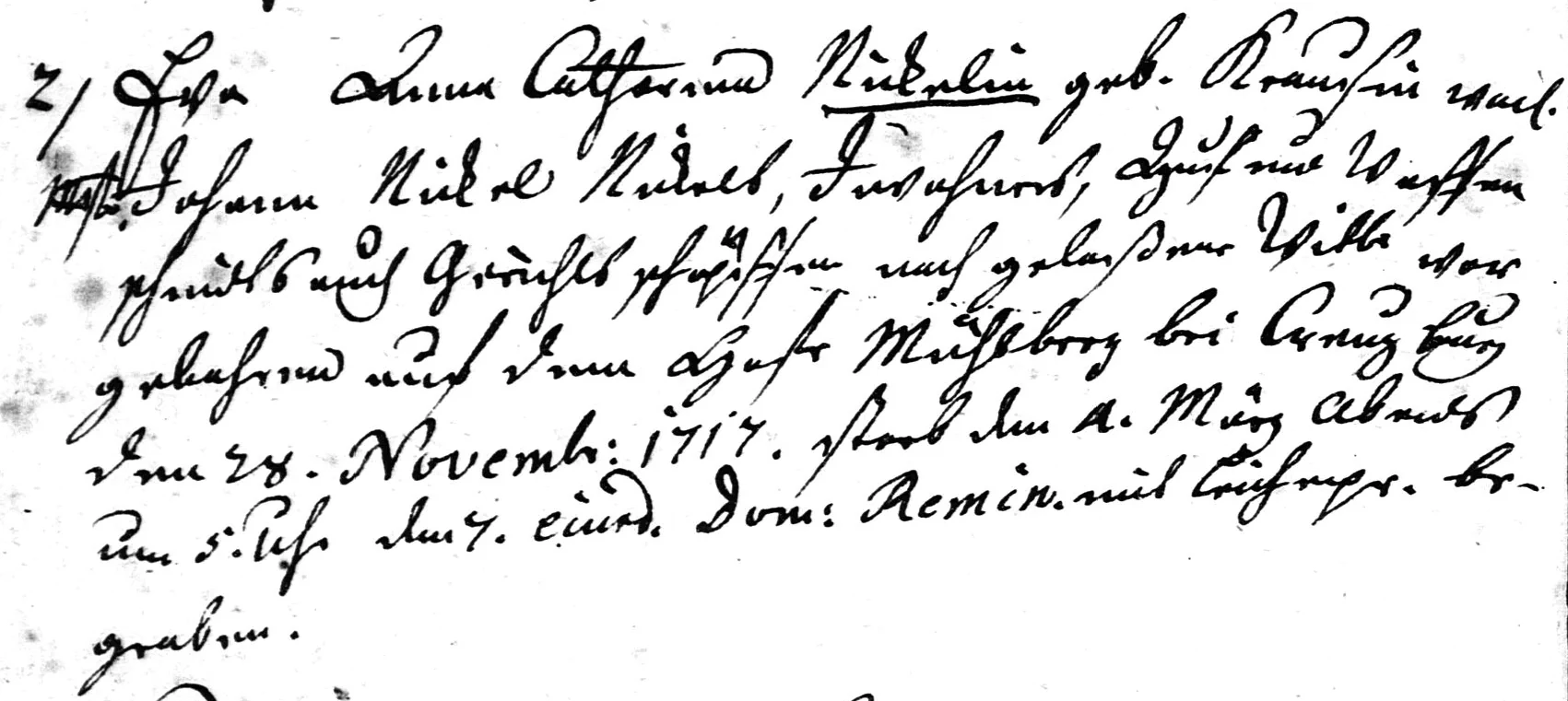
German:
Johanna Sophia, Mstr. Georg Nickols und
Schmidt
English Translations:
Family of Hans Nicolay and Anna Margaretha (Grimm) Nicol
Initially, this generation posed a challenge. I had not yet found the marriage record in the 1st church book, and did not know the birth date of Johann Nicol Nicol. It turns that the 1st Church Book is more difficult to read than the 2nd because of an annoying lack of underlining in critical years.
Here is where I got very lucky. It turns out that the marriage above had been recorded on familysearch and ancestry by someone who descends from Catharina Sebastian Nicol, a stepsister of Johann Niclas Nicol. A German native from Cologne, Frank S., had already done the heavy lifting of reading all the Nicol related entries in the 1st church book. At this point, I am relying on the conclusions of Frank regarding the family relationships. No doubt these results are correct, but I still would like to read the German translation at some point because these records sometimes add insight about our ancestors.
Here are three observations about this generation. First, 5 of 11 offspring died in childhood which highlights the perils of childhood. Second, for those looking for cousins that carry the family surname, we can see a stepbrother, Henrich, who died in the nearby town of Mihla, and a brother, Johann Wilhelm, who settled in Madelungen. Third, per Frank’s research, the church in Anna Margareta Grimm’s hometown of Diedorf is Catholic. They have not posted their records yet on Matricula (the Catholic version of Archion).
Incredibly, matching DNA survives with a very small 9 cM amount shared by my aunt and another user who descends from Dorothea Elisabetha Nichol. That makes the common ancestors as Hans Nicolay Nicol and Anna Margaretha Grimm. More of these tiny matches will surface as users update their trees with the Archion scan results.
Click here to see Record for Family of Hans Nicolay Nicol and Anna Margaretha Grimm
1680 Nicol-Ellers Marriage (Lauterbach Kirchenbuch 1620-1737, Pg 59)

German:
1680 Nicol – Ellers Marriage Record Dom. 21. Proclamizt Hanss Nicol, Herd Ernst Nicols Sol. Sohn, und Margarite Magdalena, Fr. Johann Henrich Ellers, Safuldinerss,zu
English Translations:
1696 Margareta Magalena Niclas Death (Lauterbach Kirchenbuch 1620-1737, Pg 127)

German:
Johann Georg Nicols Huf= u. Waffen Schmidt
getauft der 12te Juli
end nach Mittag geboren;
English Translations:
Johann Georg Nicols Blacksmith baptsm on the 12th July
1700 Nicol-Grimm Marriage (Lauterbach Kirchenbuch 1620-1737, Pg 65)
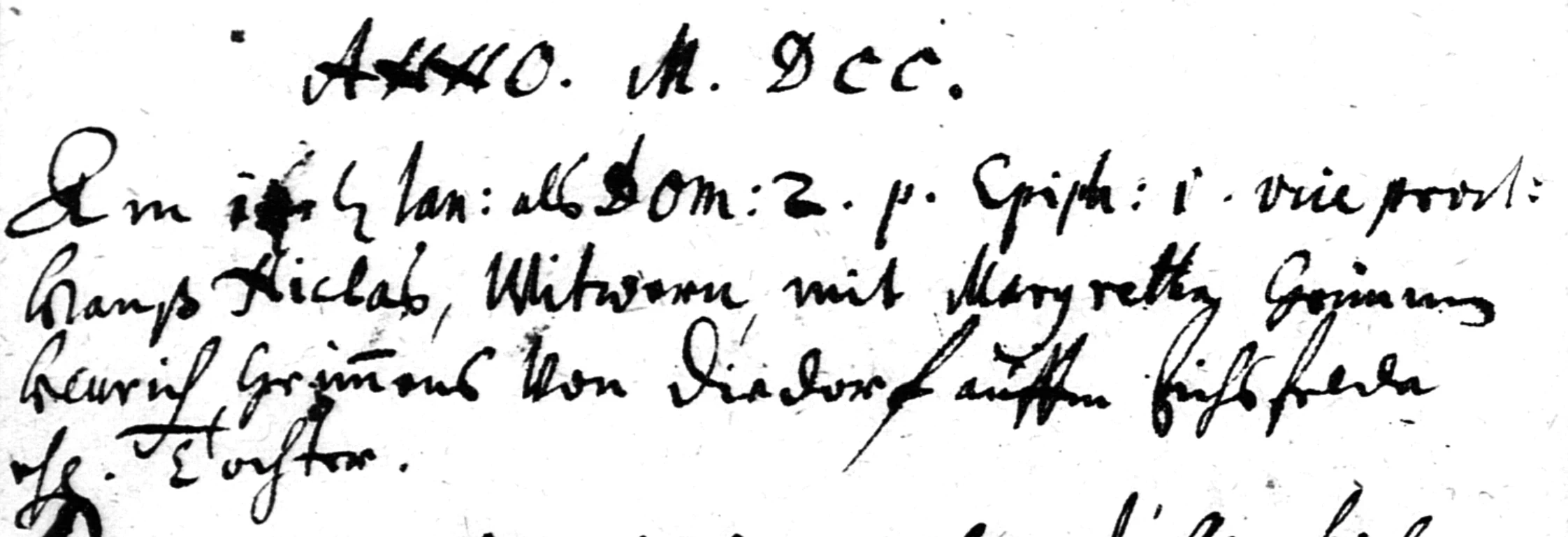
German:
Mstr. Johann Georg Nicol
Einwohner u. Huf- u. Wappen Schmidt
ahhier geboten.
Pater Mstr. Johann Conrad Luft
English Translations:
C
1702 Johann Niclas Nicol Baptism (Lauterbach Kirchenbuch 1620-1737, Pg 34)

German:
1702 Johann Niclas Nicol Baptism Der 10te Feb: gatauft Hanss Niclas Goboren Joh. Niclas, um 8. gaborane On 10th Feb Hans Niclas, son of Johann Niclas,
English Translations:
1708 Hans Nicol Death (Lauterbach Kirchenbuch 1620-1737, Pg 132)

German:
English Translations:
1709 Hasert – (Grimm) Nicol Marriage (Lauterbach Kirchenbuch 1620-1737, Pg 67)
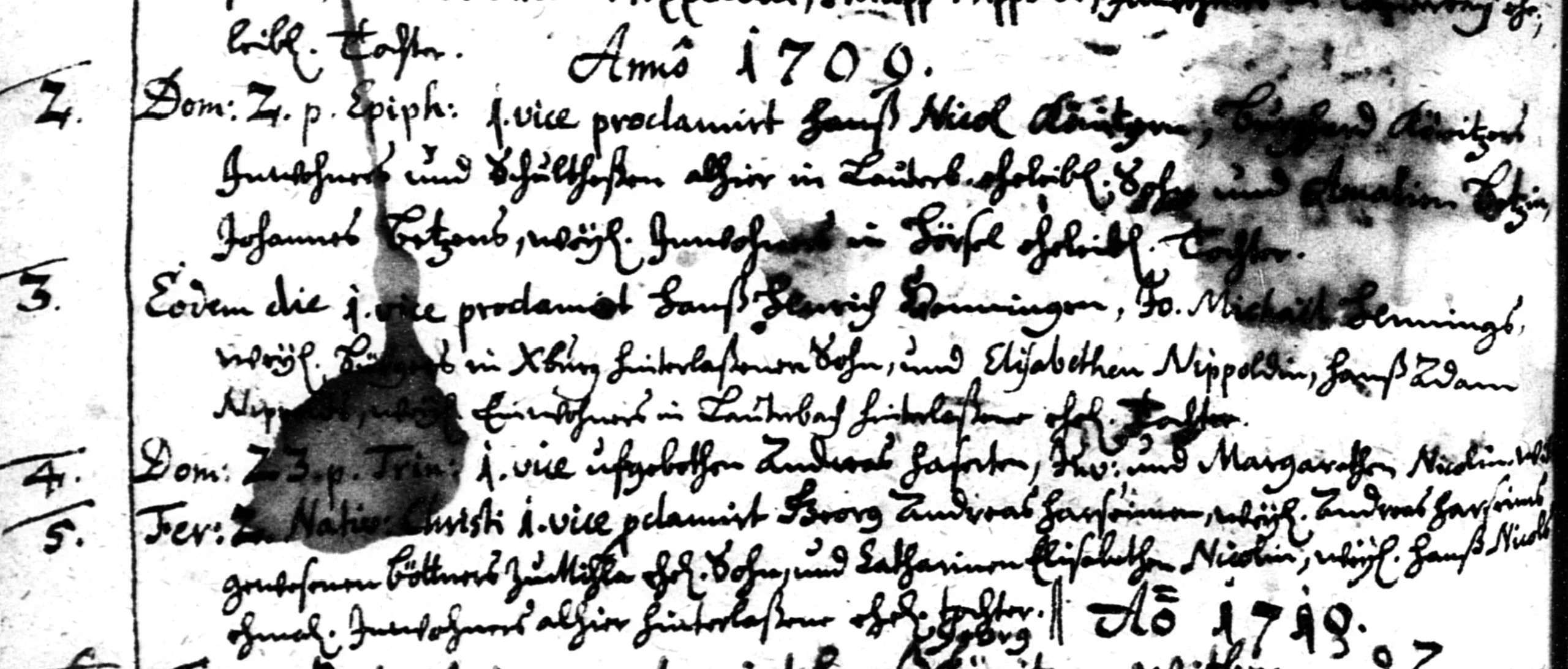
German:
Johanna Sophia, Mstr. Georg Nickols und
Schmidt
English Translations:
1752 Anna (Grimm) (Nicol) Hasert Death Record (Lauterbach Kirchenbuch 1737-1808, Pg 112)

German:
Johanna Sophia, Mstr. Georg Nickols und
Schmidt
English Translations:
Family of Herda Ernst and Sabina (Abich) Nicol
Herda Ernst, born 1609 per his death record, represents the oldest known Nicklos ancestor. Other records show him as Herd, Herden and, in 1683, Hermann. Yet Herda is highly unusual based on my research – never used in the 1600’s, and used for women afterwards. Possible clues: Herda is the name of a nearby village, the surname Herden refers to a goat herder, and the surname Hermann means “army man”.
Herda Ernest married Sabina Abich (also written as Abe or Aben) in 1848. Unfortunately, the Lauterbach church book has no earlier references to either individual.
Again, Frank came to the rescue when he searched the nearby town of Mihla where he found this same 1648 marriage recorded again. He also came across the 1625 marriage record for Hans Abich (son of Merton) from Heyerode and Elisabeth Rüger (daughter of Valten) from Herrenbreitungen. What is the connection? In the Herrenbreitungen church book sits the 1627 baptism of Sabina, daughter of Hans Abich. By the way, “Valten Rüger” has to be the coolest Saxon ancestor name ever.
The 1648 marriage record in Mihla contains another little gem. It gives Herda Ernst’s occupation as Hufschmied. That’s right, the breadwinners of this branch had a succession of blacksmiths from Herda Ernst Nicol born in 1609 to Ernst Nicolas who died in 1871, a span of 250 years.
1648 also marked the end of Thirty years War that decimated Thuringia. It started as a Protestant vs Catholic struggle for control, but devolved into something worse. The royal families around Europe would send their armies of hired guns who earned their living by fighting and pillaging. Joining an army might sound like a dangerous occupation, but it beat starving at home. Estimates put the death toll up to 8 million of soldiers and civilians. The history of nearby Creuzberg contains this account:
“Horde after horde rolled through the city, bringing misery, looting, fire, robbery, disease and death. The plague claimed those who were spared from the war. When peace was finally concluded in Münster in 1648, the Creuzburgers were at their end: a devastated city, the population more than halved and totally impoverished.”
When peace was achieved, Lauterbach found itself part of the Saxe-Gotha Duchy under the control of Ernst I (the Pious). He ushered in an era time of stability and peace by keeping taxes low and introducing a robust education system. Expansion of his land occurred in 1680 with the creation of the Duchy of Saxe-Gotha-Altenburg. An equilibrium developed. Without fail, you will find a Duke, some better than others. You will often find one of his armies fighting a war somewhere in the region. Through it all, you will always find a Nicklos working hard as a hufschmied.
Click here to Records for Family of Herda Ernst Nicol and Sabina Abich
1648 Nicol-Abich Marriage (Lauterbach Kirchenbuch 1620-1737, Pg 55)

German:
ANNO 1648
Dom. 20. Zum te mahl proclamist worden Herda Ernst Nichol Und J. Sabina, Hanß Abens ehliche tochter
English Translations:
In the Year 1648
15 October. For the first time proclaimed Herda Ernst Nichol and J. Sabina, Hans Aben’s eldest daughter
1648 Nicol-Abich Marriage (Mihla Kirchenbuch 1620-1737, Pg xxx)

German:
Am 23. Octobr. wahr montag jaest Dom. 21. Trin. wound copultst Genda Ersst Nickol, Fuv. und Huftschmidt, mit J. Sabina, Hanss Abens zu Luterbberg ehlieher tochter.
English Translations:
1649 Anna Nicol Baptism (Lauterbach Kirchenbuch 1620-1737, Pg 10)

German:
Am 26. Sept. Gekaufft Her ns Nicde
ein Junge tochter, Anna, dauff ath waneei
16
al oer zu Mihle hausfra
German:
Am 26. Sept. Getaufft Gerda Ernst Nicols
ein Junge tochter, Anna, Tauffpath wahr Hanss
Barseim, ___ bu Mihle hauss___Barseim
English Translations:
1651 Catharina Nicol Baptism (Lauterbach Kirchenbuch 1620-1737, Pg 11)

German:
H??? Ernst Nicols daughter Cathariuam baptised
English Translations:
1654 Hans Nicolay Nicol Baptism (Lauterbach Kirchenbuch 1620-1737, Pg 12)

German:
Am 11. Nov. 154, Herdan Ernst Nicols sohn getaufft
___ ___ Nicolay, Suiceptor ___ Nicol ___
English Translations:
1657 Henricus Nicols Baptism (Lauterbach Kirchenbuch 1620-1737, Pg 13)

German Translation:
Am 6. Novembr Herder Ernst Nicols sohnlein Henricus
getaufft werden, nachdem es d 5 hujas frürs umb 6 Uhr zurwelten
geboren, Tauffpather wahr Henrich Barseim alhier
English Translations:
On November 6, Herder Ernst Nicol’s son Henricus was baptized after being born on the 5th of January at 6 o’clock in the morning, the godfather was Henrich Barseim of this place
1665 Martha Nicols Baptism (Lauterbach Kirchenbuch 1620-1737, Pg 15)

German:
Dem 6te Sept. getaufte Gordas Earst Nicols tochter Ma
English Translations:
1675 Herda Ernst Nicol Death (Lauterbach Kirchenbuch 1620-1737, Pg 120)

German:
Am 27t Augusti frür hor. 3. ist verstorben Herd Ernst NICOL, so d. 29. dieses, war Dom. 13. Trin: und in Eisenachischem Fürstentum das Dankfest wegen verliehener französischer Victorien, begraben, seines Alters 66 Jahr weniger 17 Wochen und 1 Tag, Conj. 26 Jar.
English Translations:
On August 27th early morning. 3. Gerd Ernst NICOL died, so d. 29. this one was cathedral. 13. Trin: and in the Principality of Eisenach the thanksgiving festival for the French Victories awarded, buried, his age 66 years less 17 weeks and 1 day, Married 26 years
1693 Sabina Nicolin Death (Mihla Kirchenbuch 1620-1737, Pg 126)

German:
English Translations:
Hufschmeids and Waffenschmeid in Art
Fast Forward to 1850
Given the above history, how does one explain why Ernst Nicolai, wife and young son left for America in 1850? He was, after all, the oldest son who would have had the opportunity to carry on his deceased father’s business. Yet, the family joined a huge wave of one million Germans who left for America between 1850 and 1860. It started in the year 1848 with a revolution in France that spread throughout Europe, including Germany. Liberals wanted a centralized government to replace the ruling classes. While this revolution ultimately failed by 1849, it showed a widespread dissatisfaction with the status quo.
Ernst Nicolai, however, appears more economically driven than political. The Dukes had kept their borders quite closed to meaningful trade in order to stay in power. Yet outside forces began breaking down these barriers. Thuringia got its first railroads starting in the 1840’s increasing the flow of goods and creating new economic winners and losers. Ernest likely felt that his prospects had dimmed. Although the revolution failed at home, the German people fought back with their feet. Word spread that America had religious freedom, no ruling class and opportunity. Ernst may not have had family there, but Rochester had a large German community with Lutheran churches, native newspapers and jobs for a skilled tradesman.
Conclusion
We made it it back to 1609. However, keep in mind that all the churches started recording their vital starting somewhere around 1600. Therefore, this brick wall may be permanent although I hear additional records might exist in some old archive.
We can summarize our knowledge of our German ancestors with the attached seven generation fan chart. The Nicklos part has been completed. However, plenty of other ancestors remain, most of whom probably came out of the Saxe-Gotha region of Germany. I would expect that much of this chart will be populated as more Archion church books become available and get studied. Click here to see the current process of this fan chart.
